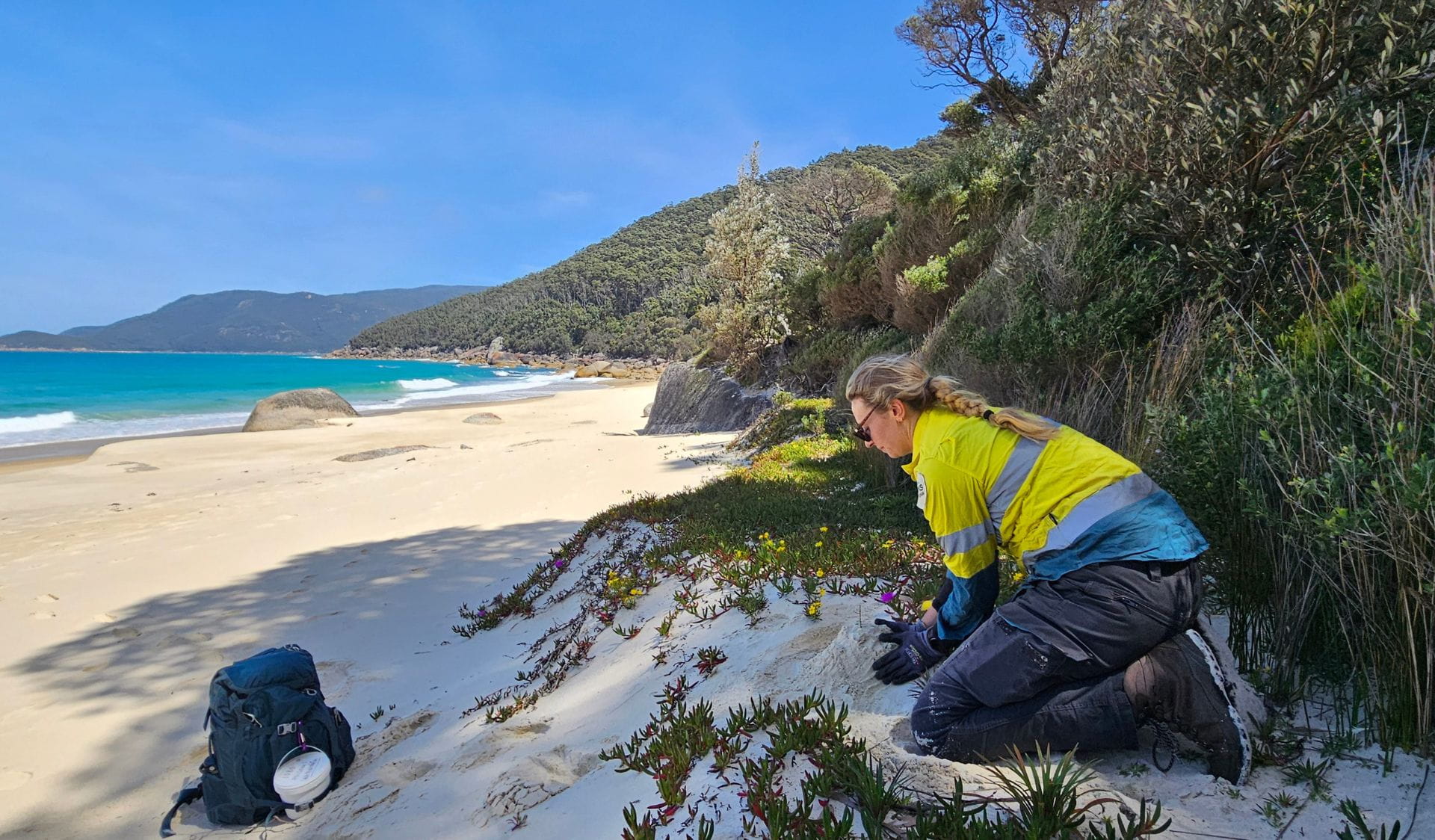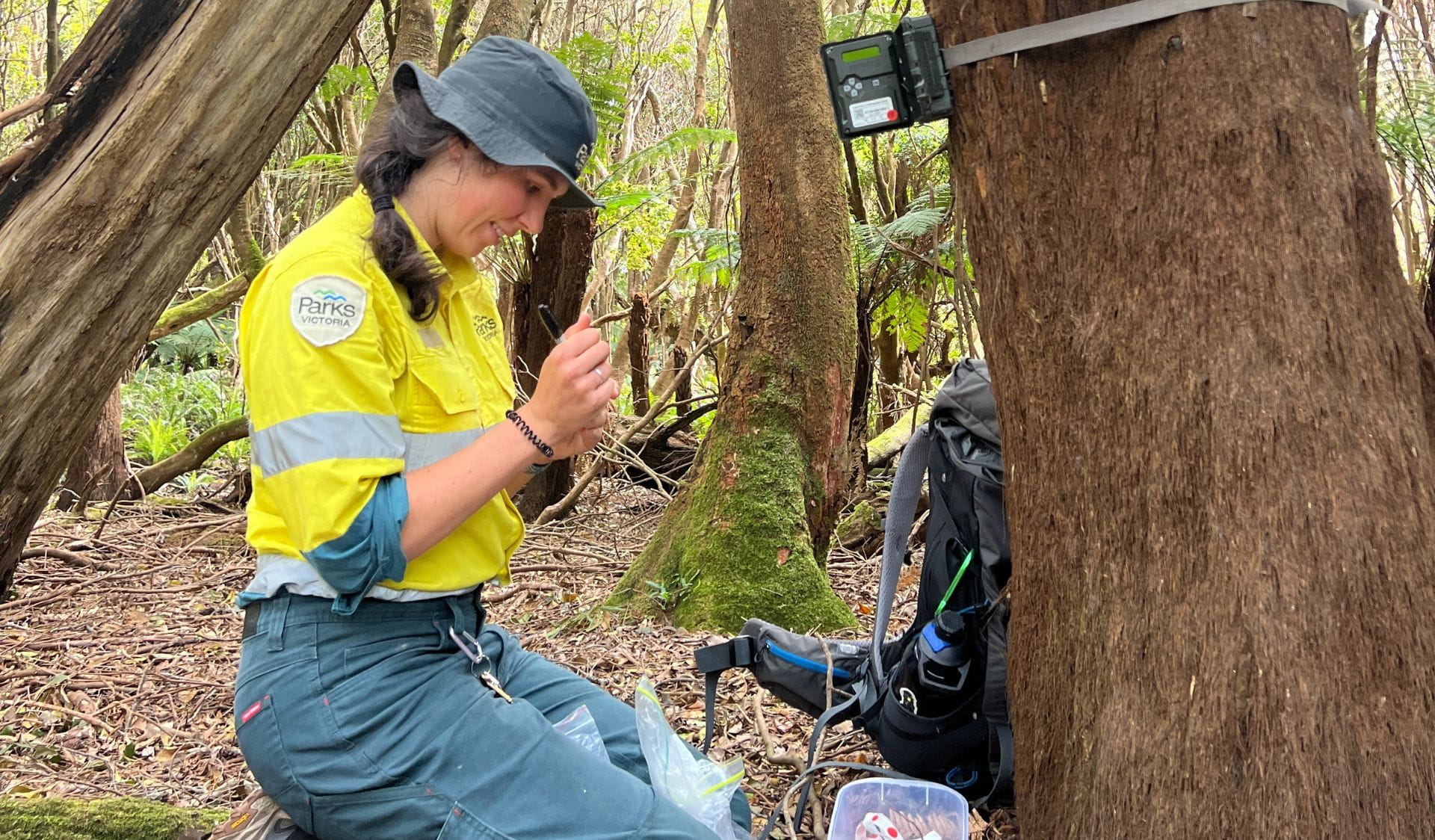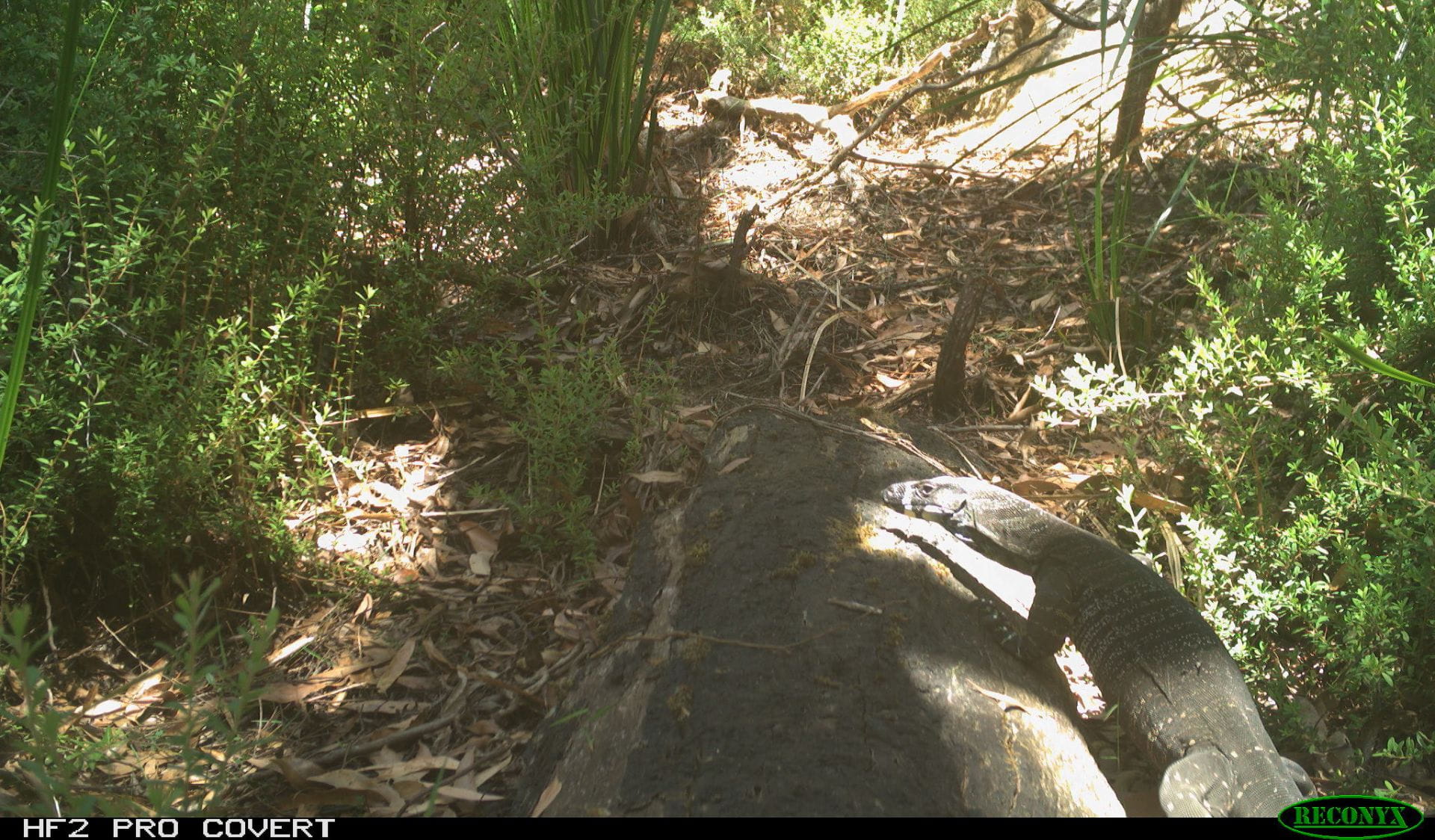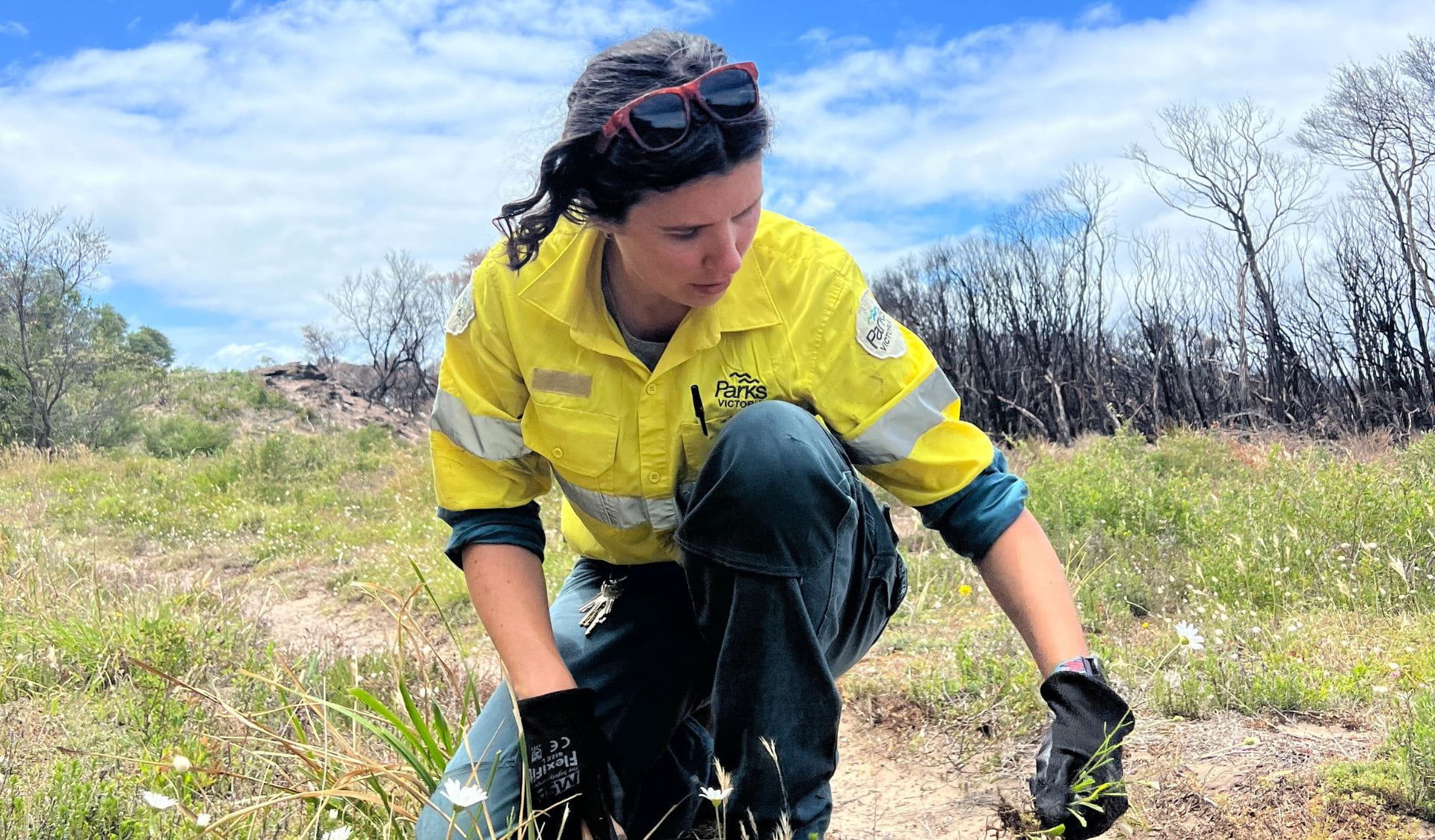Prom Sanctuary celebrates prom-ising early wins
Thursday 12 June, 2025
June 2025 update
Recent invasive species control and habitat restoration works are laying strong foundations to protect and restore Wilsons Promontory National Park’s wildlife and ecosystems.
Thanks to the dedication of passionate staff, strong partnerships with community groups and Traditional Owners, and the generosity of supporters, Prom Sanctuary is already making a difference in conserving nature and fighting extinction at the Prom.

Foxbaiting, Wilsons Promontory National Park
Prom Sanctuary is an ambitious landscape-scale conservation project to establish a 50,000-hectare climate refuge for nature and threatened species, buffered by the cool waters of Bass Strait, at Wilsons Promontory National Park.
Parks Victoria and its partners are intensifying efforts to control invasive predators, restore habitats, and build a 10-kilometre fence at the park entrance to achieve this vision.
Latest project updates
While the Prom Sanctuary Project is still in its early stages, the team are already celebrating some exciting wins, made possible by the generosity of supporters like you!
- We reached a significant fundraising target of over $400,000, thanks to generous public and philanthropic contributions, and unlocked matched funds from the Victorian Government’s Nature Funds grants program. The $800,000 in funding will now enable major grassland, heathland and island restoration projects to proceed, supported by a dedicated project officer.
- Threats to native wildlife are reducing thanks to successful invasive species control programs for deer, foxes and cats. More than 1,200 deer have been removed, and vegetation is already recovering. Deer tracks that cause erosion and allow foxes and cats into sensitive habitats are already disappearing. Our geospatial team is using satellite imagery of trails and vegetation to monitor this recovery.
- Restoration of native grasslands is underway following a significant ecological burn on the Yanakie Isthmus last September, with endangered Coastal Bitterbush already showing signs of recovery in areas once dominated by invasive Coastal Teatree.
- Fence design and planning for construction is progressing with the final alignment now chosen. The design and route have been selected to minimise impacts on cultural and natural values, including wildlife welfare needs (e.g. wombat gates). Construction is scheduled to commence this summer, to be completed by mid-2026.
- Research and monitoring efforts are ramping up, with additional cameras being deployed across the park to track deer and key native species. Our science team is working to develop automated image searching and analysis using AI machine learning to efficiently review hundreds of thousands of images. Exciting early discoveries include the first confirmed images in decades of the Lace Monitor (giant goannas that can reach 2 metres long), regular visits to bait stations by tiny Eastern Pygmy Possums, and many Long-nosed Bandicoots, Southern Brown Bandicoots, Long-nosed Potoroos, Lewin’s Rail, Rikali (or water rat - our native river otter equivalent), Dusky Antechinus and White-footed Dunnarts.
- Reptile survey tiles have been deployed in the park with early detections of threatened Swamp Skinks. Staff have been safely negotiating their way around discovery of a group of baby Copperhead Snakes. Raised bait station platforms are also being trailed to attract and assess Lace Monitor numbers across larger areas of the park.
- Sound recording units have been deployed at the northern end of the park, targeting detection of the elusive King Quail and Ground Parrots. The units are also being used to identify frogs in the area.
- Reintroduced Eastern Bristlebirds are thriving and have now extended outside their original release area in the Vereker heathlands. We are expanding our predator control areas to match the needs of the growing colony.
- Marine health checks have been carried out, with the team undertaking structured Rapid Health Assessments dives to check the health of the marine life and diverse marine habitats – from kelp forests and sponge-lined caves to seagrass meadows and sand plains.
- Koala habitat restoration is progressing well at the Prom Wildlife Walk, with over 200 trees planted by Friends of the Prom volunteers at a recent volunteer day. Encouragingly, koalas have been regularly sighted in the revegetated areas.

Ruby undertaking deer monitoring

The first confirmed images of Lace Monitor in decades
Meet the team
Meet Ruby, Project Coordinator (Invasive Species)

Ruby leads the invasive species team for Prom Sanctuary, managing a range of programs such as deer control, fox baiting, cat trapping and weed control.
Recently the team finished a highly successful six-week fox baiting pulse and an aerial deer operation.
So far, Ruby’s favourite part of the project has been discovering and controlling a highly invasive weed, Blue Hounds Tongue (Cynoglossum creticum), the first record of this dangerous species occurring in Victoria. Contractors were instrumental in discovering the weed and Ruby then liaised with multiple agencies to formally identify and manage the species. It turns out wombats were part of this weed’s puzzle – they were spreading seeds from visitor areas into nearby bush.
For Ruby, the best part of her job is getting to work in off-track areas of the park that people don’t usually get to experience, such as the remote southern section of the park where her team spent a month installing wildlife cameras to detect introduced predators. “We spent weeks trekking around in the sun, wind and rain slogging through walls of coral fern!”
Looking ahead
Weed control operations are set to commence on the Prom’s remote offshore islands in the coming months to reduce invasive species and safeguard critical habitats for migratory seabirds such as Short-tailed Shearwaters and Fairy Prions, colonies of Little Penguins and Australian Fur Seals, and the homes of Swamp Antechinus, tiny marsupial predators related to Tasmanian Tigers and Devils, that are abundant on the islands.
Accessing these islands presents significant logistical challenges – boat or helicopter transfers are required which is not an easy feat given the unpredictable weather and strong winds often found on these rugged offshore islands. We’ll keep you updated on our progress.
Support Prom Sanctuary
Earlier this year, Prom Sanctuary reached a significant milestone. Parks Victoria worked with long-term charity partner, People and Parks Foundation to raise over $800,000 to carry out major habitat restorations as core steps in establishing Victoria’s largest conservation sanctuary.
As much as $25 million is needed to realise the full potential of the Prom Sanctuary project. To help support this critically important work through a tax-deductible donation, visit the People and Parks Foundation website.
The People and Parks Foundation is a long-term charity partner of Parks Victoria. It is an Australian charity registered with the Australian Charities and Not-for-profit Commission and is trustee for the People and Parks Environment Trust (Deductible Gift Recipient 1).
About Prom Sanctuary
Prom Sanctuary is a 20-year vision to establish a climate change refuge where vulnerable wildlife and habitats thrive, at Wilsons Promontory National Park, affectionately known as ‘the Prom’.
Spanning 50,000 hectares at the southernmost tip of mainland Australia, the Prom is home to more than 150 threatened species of native plants and animals, encompassing 10 major ecosystem types. Valued and cared for over tens of thousands of years by Victoria’s Traditional Owners and protected as a national park for more than a hundred years, it has survived the scale of disruption and land clearing that occurred elsewhere around the state and nation.
Surrounded by the cool waters of Bass Strait, it is naturally buffered from climate change temperature extremes and is always 5-10 degrees cooler than the adjacent mainland, making it an ideal climate change refuge for local species, bringing back those lost to the area, and species in need elsewhere.
This unique location, its cultural significance, history, geography and natural beauty make it an ideal refuge for wildlife. As a beloved destination for around half a million Victorians and interstate and international visitors each year, it is also an ideal place to deeply connect people with nature and build support, advocacy, action and champions for nature’s needs in challenging times.
Watch the video below to learn more about Prom Sanctuary.

